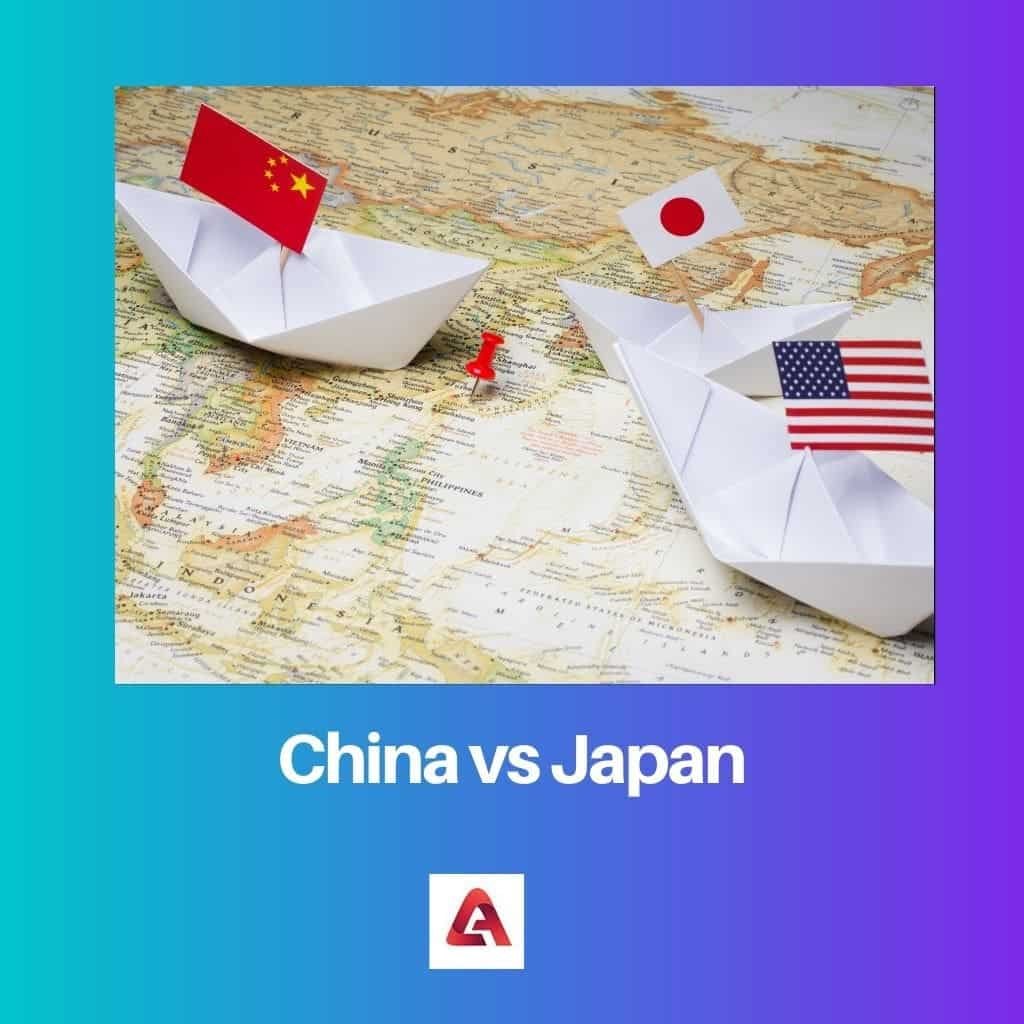China and Japan, two East Asian powers, have complex historical and geopolitical relations marked by tensions over territorial disputes, wartime legacies, and economic competition. Despite occasional diplomatic efforts to improve ties, lingering animosities and strategic rivalries continue to shape their interactions, impacting regional stability and global dynamics.
Key Takeaways
- China has a larger land area, population, and economy, while Japan is an archipelago with a smaller population and a more advanced economy.
- The Chinese language uses simplified characters and has multiple spoken dialects, while the Japanese language employs three scripts (hiragana, katakana, and kanji) and has a single standardized dialect.
- Chinese culture significantly influences Japanese culture, but Japan has developed unique elements such as tea ceremonies, martial arts, and anime.
China vs Japan
China is the world’s most populous country and has a large landmass, while Japan is an archipelago of four main islands with a smaller land area and population. China’s economy is primarily based on manufacturing, while Japan’s is driven by technological innovation and exports. China has a long history of dynastic rule, while Japan is a constitutional monarchy with a solid imperial history.

China has a vast landmass; it is the third-largest country in the world, while Japan is an island nation comprising more than 6500 islands in it.
Comparison Table
| Feature | China | Japan |
|---|---|---|
| Political System | Communist Republic | Parliamentary Constitutional Monarchy |
| Head of State | President | Emperor (symbolic) |
| Head of Government | Premier | Prime Minister |
| Population | 1.45 billion | 125 million |
| Area | 9.6 million km² | 378,000 km² |
| Official Language | Mandarin Chinese | Japanese |
| Major Religions | Buddhism, Taoism, Confucianism | Shinto, Buddhism |
| Currency | Renminbi (RMB) | Japanese Yen (JPY) |
| GDP (nominal) | $17.96 trillion | $4.23 trillion |
| GDP per capita (PPP) | $12,600 | $42,440 |
| Economic System | Socialist market economy | Mixed economy with capitalist tendencies |
| Major Industries | Manufacturing, services, agriculture | Manufacturing, services, finance |
| Technology | Rapidly developing | Highly advanced |
| Education | Literacy rate: 97.9% | Literacy rate: 99% |
| Healthcare | Universal healthcare system, but quality varies | Universal healthcare system with high quality |
| Life Expectancy | 77.4 years | 84.8 years |
| Social Security | Basic system, undergoing reforms | Comprehensive system |
| Environmental Issues | Air and water pollution, deforestation | Limited resources, natural disasters |
| Foreign Policy | Increasingly assertive | Pacifist, focused on alliances |
| Military | Largest standing army in the world | Self-Defense Forces focused on defense |
| Culture | Diverse, influenced by Confucianism | Homogeneous, emphasis on harmony and respect |
| Food | Rice, noodles, dumplings, vegetables | Rice, fish, noodles, tofu |
| Arts | Calligraphy, opera, traditional painting | Bonsai, anime, manga, kabuki theater |
What is China?
China, officially known as the People’s Republic of China (PRC), is the world’s most populous country, situated in East Asia. Covering approximately 9.6 million square kilometers, China is the third-largest country by land area. With a rich history spanning over thousands of years, China has made significant contributions to art, philosophy, science, technology, and governance.
The Chinese civilization, one of the world’s oldest continuous civilizations, has seen the rise and fall of numerous dynasties, each leaving a profound impact on the country’s culture, society, and governance systems. The last imperial dynasty, the Qing Dynasty, ended in 1912, leading to the establishment of the Republic of China (ROC). However, following a civil war between the Chinese Nationalists (led by the Kuomintang) and the Communists (led by the Chinese Communist Party, CCP), the CCP emerged victorious in 1949, establishing the People’s Republic of China on the mainland while the ROC retreated to Taiwan.
Under the leadership of the CCP, China underwent significant socio-political transformations, including the implementation of socialist policies, land reforms, and the Great Leap Forward. However, these policies also led to various challenges and tragedies, such as the Cultural Revolution, which caused widespread social upheaval and economic disruption.
Since the late 1970s, China has embraced economic reforms and opening-up policies under the leadership of Deng Xiaoping, transitioning from a centrally planned economy to a socialist market economy. This shift unleashed decades of rapid economic growth, leading to China becoming the world’s second-largest economy by nominal GDP and the largest exporter and manufacturer.
China’s political system is characterized by single-party rule under the CCP, with President Xi Jinping serving as the paramount leader since 2012. The CCP maintains tight control over political, social, and economic activities, employing censorship and surveillance to suppress dissent.
In recent years, China has sought to increase its global influence through initiatives like the Belt and Road Initiative (BRI), aimed at enhancing infrastructure connectivity and fostering economic cooperation across Asia, Africa, and Europe. Additionally, China has become increasingly assertive in territorial disputes in the East and South China Seas, leading to tensions with neighboring countries and the United States.
Today, China plays a crucial role in shaping global affairs, with its actions and policies influencing international trade, security, and environmental issues. However, its rapid rise as a global power also presents challenges and uncertainties, as the world navigates the complexities of China’s growing influence and its implications for global governance and stability.

What is Japan?
Japan, officially known as the “State of Japan,” is an island nation situated in East Asia. It consists of a stratovolcanic archipelago that stretches along the Pacific coast of Asia, with its four largest islands—Honshu, Hokkaido, Kyushu, and Shikoku—comprising about ninety-seven percent of its land area. Additionally, Japan encompasses thousands of smaller islands, including the Ryukyu Islands and the Ogasawara Islands.
The country has a rich cultural heritage, blending traditional customs and practices with modern advancements. Japanese culture is renowned worldwide for its contributions to various fields such as art, cuisine, literature, architecture, and technology. Traditional arts like tea ceremonies, flower arranging (ikebana), and calligraphy, alongside contemporary pop culture phenomena like anime, manga, and video games, reflect the diverse facets of Japanese society.
Japan boasts a highly developed economy, characterized by advanced technology, efficient manufacturing processes, and global competitiveness in industries such as automotive manufacturing, electronics, robotics, and precision machinery. It is one of the world’s largest economies, with a sophisticated financial sector and a strong emphasis on innovation and research and development.
The political system of Japan is a parliamentary democracy with a constitutional monarchy, where the Emperor serves as a ceremonial figurehead while the elected Prime Minister holds executive authority. The government operates under a constitution adopted in 1947, following the end of World War II, which renounces war and prohibits the maintenance of armed forces for aggressive purposes.
Despite its relatively small size in terms of land area, Japan’s strategic location, economic influence, and technological prowess have positioned it as a significant player in regional and global affairs. The country faces various challenges, including an aging population, environmental concerns, and ongoing territorial disputes, but it continues to adapt and innovate to maintain its status as a leading global power.

Main Differences Between China and Japan
- Geography: China is a vast continental country with diverse landscapes, while Japan is an island nation comprising multiple islands in the Pacific Ocean.
- Political Systems: China is governed by the Communist Party of China (CPC) in a one-party system, while Japan operates as a parliamentary democracy with a constitutional monarchy.
- Cultural Heritage: China has a long history dating back thousands of years, with a rich cultural heritage including Confucianism, Taoism, and Buddhism, while Japan also has a deep cultural heritage but with distinct traditions such as Shintoism and Zen Buddhism.
- Language: Mandarin Chinese is the predominant language in China, while Japanese is the primary language in Japan, with distinct writing systems including kanji, hiragana, and katakana.
- Economic Development: China has experienced rapid economic growth and is one of the world’s largest economies, while Japan has a highly developed economy with a focus on technology, manufacturing, and innovation.
- Historical Relations: China and Japan have a complex history marked by periods of cooperation, cultural exchange, and conflict, including territorial disputes and wartime legacies.
- Foreign Policy: China pursues a policy of non-interference and strategic assertiveness in global affairs, while Japan maintains a pacifist stance due to its post-World War II constitution but has been increasing its involvement in regional security issues.
- Social Structure: Chinese society is influenced by Confucian values emphasizing hierarchy and respect for authority, while Japanese society places importance on group harmony and consensus-building.
- Cuisine: Chinese cuisine is diverse and includes regional variations such as Sichuan, Cantonese, and Hunan cuisine, while Japanese cuisine is known for its emphasis on fresh ingredients, meticulous preparation, and presentation, including sushi, sashimi, and tempura.
- Technology and Innovation: Both countries are leaders in technology and innovation, with China excelling in areas like telecommunications, e-commerce, and renewable energy, while Japan is renowned for its advancements in robotics, electronics, and automotive engineering.






